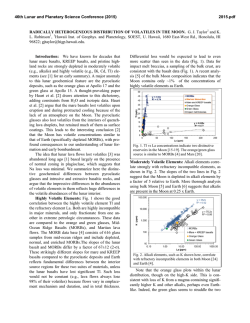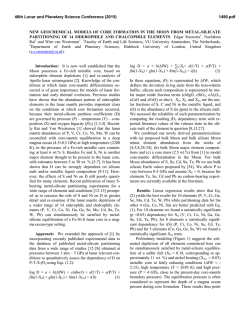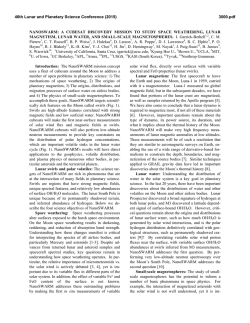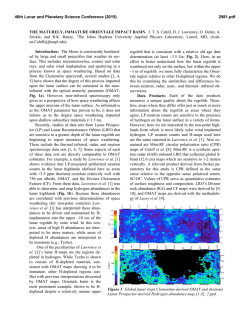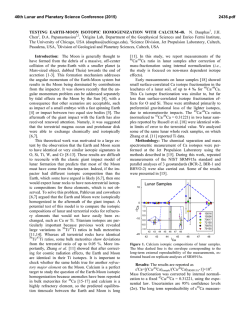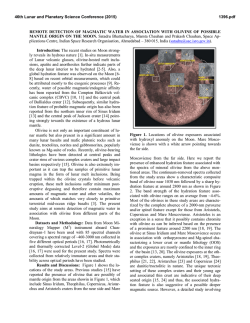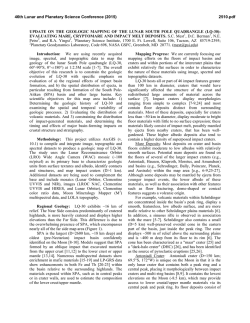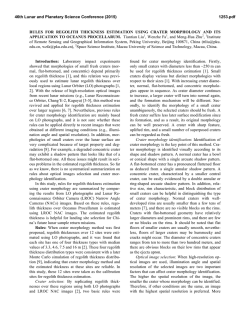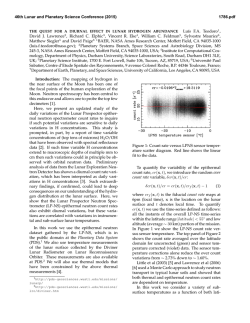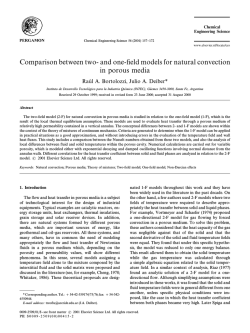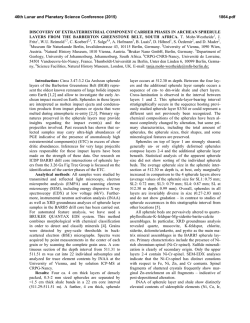
A THERMAL MODEL TO STUDY THE EFFECT OF TOP POROUS
46th Lunar and Planetary Science Conference (2015) 1768.pdf A THERMAL MODEL TO STUDY THE EFFECT OF TOP POROUS LAYER ON SUBSURFACE HEAT FLOW OF MOON K. Durga Prasad, Vinai K. Rai and S.V.S. Murty, PLANEX, Physical Research Laboratory, Ahmedabad 380009, India ([email protected]) Introduction: Precise estimation of equilibrium boundary between external and internal heat fluxes is necessary to infer the net heat flow on the Moon. This requires an in-depth understanding of the lunar nearsurface thermal beahviour. Apollo era in-situ measurements are the only data available for this purpose. However, the results of these experiments were biased by the parameters of the measurement site[1,2]. Various models have been developed over time [3-5] but with limited aim of predicting surface temperatures and validate remote sensing observations. Regional geophysical modelling of Apollo sites was also attempted using a three-dimensional model but on a global scale [6]. The best effort so far has been based on numerical modelling (supported by Apollo and remote sensing observations), invoking a two-layer model for lunar surface with an outer-most porous layer of ~2cm followed by a denser layer beneath [3,7]. Although the presence of ~2 cm surficial fluffy layer on the Moon has been validated through remote sensing and numerical modelling, its nature, exact thickness and spatial extent are to be well constrained, as this porous layer principally dictates the propagation of solar heat influx to the interior layers. We have developed a three-dimensional finite element model (FEM) of the lunar near surface to understand the thermal behaviour within this regime and some preliminary results from the model are presented here. Model description: Our 3-D finite element model utilizes a multi-layer approach and is developed using COMSOL multiphysics environment including heat transfer module. A schematic of the model is depicted in Figure 1. It consists of two-layers: a top porous layer followed by a regolith layer beneath. The number of layers, layer thickness and their dimensions can be varied as required. The model facilitates a number of features viz. complex geometry, different size and irregular shaped meshes, parametric-based variation in physical properties etc. for the layers of the model. At present, the model is designed to account for local to regional scale variations. In order to account for the outermost fluffy layer followed by low-density regolith layers, the model is implemented to solve heat transfer equation (1) for porous media for both the domains. (ρCp)eq(δT/δt) + ρCp u . ▽T = ▽ .(λeq▽T) + Q (1) where 'ρ' is density, 'Q''is the heat source, (ρCp)eq' and ' λeq ' are the equivalent volumetric heat capacity and Figure 1: Schematic of 3D-Lunar Surface Model for two layers the thermal conductivities of the porous media respectively. The parameters used in the model for simulations are shown in table 1. Table 1: Parameters used for the present study Parameter Density (ρ) Thermal Conductivity (λ) Specific heat (Cp) Porosity (φ) Porous Layer 800 kg/m3 .00092 W/m.K Regolith Layer 1900 kg/m3 Ref. 8 .0093 W/m.K 8 840 J/ (kg.K) 60% 840 J/ (kg.K) 40% 8 9 All the simulations were carried out for a block with plane surface of area 2m x 2m and height of 1m including all the layers. For the present work, only two layers were considered. A semi-sinusoid function for surface temperatures calculated from solar heat flux was considered as the boundary heat source, and the initial value of temperature boundary condition was considered as 250 K and 150 K for equator and polar latitudes respectively[8]. Results and Discussion: Using the above model, we have carried out simulations for equatorial and polar latitudes. We have experimentally showed earlier that the grain size and porosity/density of the porous layer significantly effects the heat propagation to the subsurface layers [10] which implies that the thickness of the porous layer needs to be well-constrained. Calculations were repeated for porous layers of various thickness. All the simulations were carried out for 2 synodic periods of the Moon and time evolution of surface and sub-surface temperature both in vertical and lateral directions was monitored. Some prelimi- 46th Lunar and Planetary Science Conference (2015) 1768.pdf nary results obtained from the model are presented here. Latitude variation of Subsurface Temperatures: The variation of subsurface temperatures at depths of 2cm, 10 cm and 20 cm for equator (0o, solid line) and polar (89o, dotted line) latitudes is shown in Figure 2. The results are in agreement with those predicted by earlier models, in particular for near surficial depths. Diurnal skin depth for equatorial latitudes found from the simulations provides a limit of ~20-30 cm as predicted earlier. However, at polar latitudes the diurnal skin depth has been found to be much shallower than that at the equator. Figure 2: Model calculated diurnal lunar subsurface temperatures at equator and polar latitudes Effect of thickness of porous layer: Figure 3a and 3b show the time evolution of subsurface temperatures at depths of 10 cm and 20 cm for 3 different scenarios Single layer model and 2 Two Layer models with 2cm and 10cm uppermost porous layer respectively. Figure 3 clearly shows the effect of uppermost porous layer in inhibiting the heat propagation to the subsurface layers. However, from the result it appears that the dependence of heat propagation to the interior on the extent and spatial variability of the uppermost layer appears to be relatively complex and needs further detailed study. Summary and Future Work: We have developed a three dimensional finite element model to understand the thermal behaviour of the near-surface regolith of the Moon. Qualitative analysis of our preliminary simulation results showed that the subsurface heat propagation has a large dependence on the thickness of the upper most porous layer. Heat propagation within the Figure 3: Model calculated diurnal lunar subsurface temperatures as a function of porous layer thickness subsurface layers at high latitudes appears to be relatively slower than that at the equator. However, best estimation of this can be done only from wellconstrained parameters of the surface at high latitudes. In short, the subsurface heat flow in the presence of an outermost porous layer appears to be more complex. A detailed study to understand the effect of thickness and spatial variability of this porous layer in conjunction with real topography of the Moon is underway. References: [1] Warren and Rasmussen (1987) JGR, 92 [2] Wieczorek and Phillips (2000), JGR 105 [3] Vasavada et al., (1999), Icarus 141, 179-193 [4] Hiesinger and Helbert (2009) 40th LPSC #1789.pdf [5] Christie et al., (2008) NASA/TM-2008-215300 [6] Siegler and Smrekar (2014) 45th LPSC #2100.pdf [7] Langseth and Keihm (1997) Cosmochemistry of Moon and Planets 283-293 [8] Balasubramaniam et al., (2011) J. Thermophysics and Heat Transfer 25(1), 130-139 [9] Slyuta (2014) Solar System Research 48(5), 330-352 [10] Durga Prasad and Murty (2014) 45th LPSC #1236.pdf
© Copyright 2026
